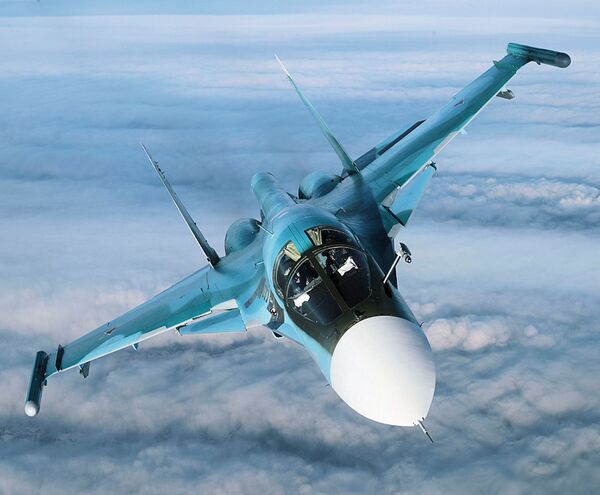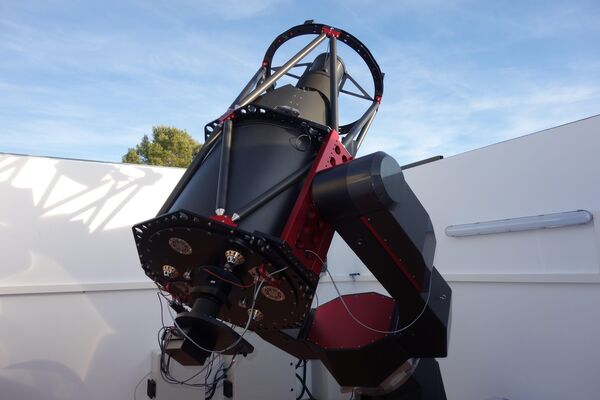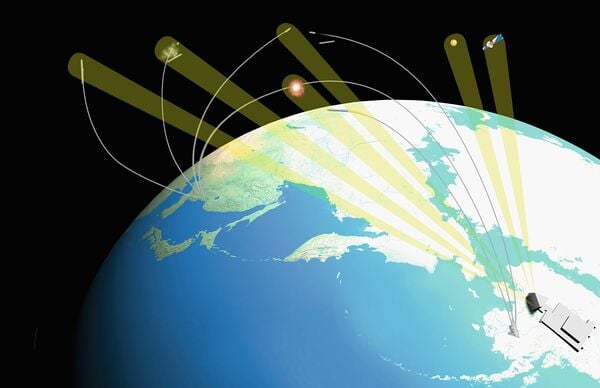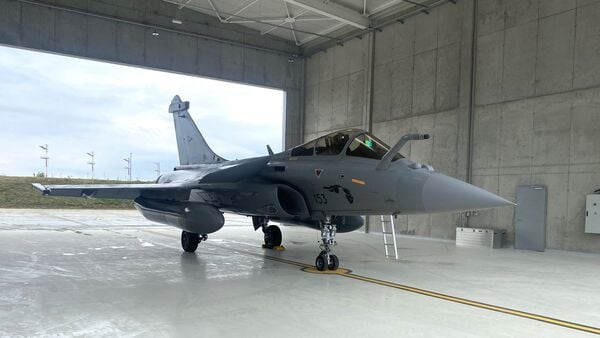- About
- Intara
- Capabilities
- Advisory
- Resources
- News
- Store
Ukraine conflict: Is the VKS underperforming?
03 March 2022


The VKS order of battle includes a wide range of aircraft, such as the Su-34 ‘Fullback', which has been observed operating over Ukraine (file photo). (Russian Ministry of Defence)
Military doctrine dictates that neutralising opposition air defences and air forces to enable freedom of movement for ground elements and facilitate air-to-ground operations should be a core aspect of any invasion plan. Although, at present, it is impossible to accurately quantify air losses on either side, there is no question that, after seven days of conflict, Russia has failed to achieve air superiority over Ukraine, let alone air supremacy. Furthermore, the Russian Air Force (Vozdushno-kosmicheskiye sily - VKS) has not played a decisive role in supporting the ground offensive.
Several factors could be at play to explain this failure. The first being that, at the strategic level, it wasn't ever intended to be that sort of operation and the massive application of air power was not considered necessary. There is evidence that the degree of Ukrainian resistance to a supposedly overwhelming opposing force was seriously underestimated, with the Ukrainian population expected to either welcome Russian forces with open arms or at least be ambivalent to an occupation.
Even if stiff resistance was expected, another question is how far in advance did VKS planners have sight of the full extent of the operation. Effects-based targeting is both time-consuming and resource-intensive, and to be effective, it would have taken from weeks to months to identify, gather, and assess the necessary information on target types and locations. While there was undoubtedly a limited VKS shaping air campaign, employing predominantly cruise and ballistic missiles to target both airfields and air defences, it was clearly ineffective and the Ukrainian Air Force and its air defence elements have continued to operate, albeit at a lower capacity.
Along with thorough planning, effective targeting depends to a large extent on the use of precision-guided munitions (PGMs), which are available to the VKS in limited numbers and require a significant amount of training to be successfully employed. Historically, available flying hours for VKS pilots are extremely low compared with other modern air forces, averaging approximately 10 hours per month.
Given these limitations, the VKS would normally resort to unguided weapons, employed on a greater scale to make up for the lack of precision. However, this type of employment appears to have been sporadic and limited so far. This supports the view that the VKS has been deliberately holding back in its offensive campaign rather than lacking the capability. Whether this has been to preserve combat power for later in the operation or in the misapprehension that Ukraine wouldn't fight remains to be seen, but worryingly, the likelihood is that we would expect to see a significant increase in airstrikes in the coming days with increasingly indiscriminate targeting, including of urban areas, tactics previously employed by the VKS in other operations including in Chechnya and Syria.
At a more strategic level, if significant air combat capability is deployed in support of the Ukrainian campaign, the overall sustainability of the VKS in the long term may be a further consideration.
From a tactical, close air support perspective, the apparent limited effectiveness of the VKS is easier to explain. Co-ordination between air and ground forces is technically and procedurally challenging, requiring a robust communications architecture and well-rehearsed processes. It is highly unlikely that most of the Russian ground formations will have the required enablers in place, nor will they have trained in joint land/air operations and, with both sides using similar ground equipment types, the potential for fratricide would be significant.
The same is true for the employment of Russian organic air defences where, despite identification friend-or-foe (IFF) procedures, the likelihood of procedural errors would be high, putting their fighter ground attack (FGA) aircraft at risk. When coupled with Ukraine's surface-to-air missile (SAM) capabilities, which are likely to be dispersed and employed using ‘shoot and scoot' tactics, under decentralised control and potentially using advanced Western manportable air-defence systems (MANPADS), the threat environment for the VKS in the ground attack role will be high.
The attrition rate of the Ukrainian Air Force is unknown, but unconfirmed reports suggest they have been at least partially successful in the defensive counter-air role. How long this capability remains viable is unclear, however, renewed Russian attacks from both air and ground against Ukrainian airfields are likely to ultimately neutralise this threat.
The poor performance of the VKS to date is probably not explained by a single issue, but a combination of factors. The relative lack of VKS offensive and defensive counter-air activity over the whole area of operations cannot be explained solely by the remaining threat, but will likely be a contributory factor, to which a combination of limited aircrew experience and training, a lack of precision munitions, and poor air/ground co-ordination are likely playing a role. However, the biggest factor is likely to be that the need for a comprehensive air campaign to both shape the operational environment and support ground forces was never envisaged as being necessary, and therefore not planned for.
Superficially, the poor performance of the VKS to date is good news for the defenders and will have enabled Ukrainian ground forces a level of freedom of movement they would not have expected. However, in an effort to reinvigorate a stalling operation, a significant ramping up of Russian air activity in all roles can be expected, utilising the superior numbers of aircraft the VKS has at its disposal. Worse, as the steadfast resolve of the Ukrainian population continues to frustrate Russian ground forces, and as they begin to shape operations around Kyiv, the potential for wide-scale, indiscriminate bombing as witnessed in Aleppo in Syria is very real. Whatever happens, the limitations of the VKS in all roles have been significantly exposed.
Air Vice-Marshal Sean Corbett (retd) is the founder and CEO of IntSight Global and chairman of Janes National Security Advisory Board. He retired from the Royal Air Force in September 2018 after a 30-year career as a professional intelligence officer. His last appointment in the military was in Washington, DC as the first non-US deputy director of a major US intelligence agency.
UK explores new radar and IR tech to enhance SDA
26 April 2024
by Olivia Savage


UK company Spaceflux has been contracted to develop and operate a ground-based SDA sensor as part of Project Nyx Alpha to monitor objects in GEO for UK Space Command. (Spaceflux)
The UK's Defence Science and Technology Laboratory (Dstl) is conducting three technology demonstrator programmes to explore the utility of novel space domain awareness (SDA) technologies.
The first programme is exploring the development of a Deep Space Radar (DSR) designed to monitor and protect geostationary orbit (GEO) assets such as the Skynet satellite communications system, William Feline, senior principal advisor for SDA at the UK Ministry of Defence (MoD), said at the Military Space Situational Awareness Conference 2024, held in London from 22 to 24 April.
The purpose of the programme is also to assess whether the UK needs its own DSR capability or whether it can rely on or complement the Deep Space Advanced Radar Capability (DARC) currently being developed alongside Australia and the US, Emma Kerr, senior principal engineer for SDA at Dstl told Janes .
A monostatic or biostatic system is being considered as well as whether a new or existing system is required, Feline said.
MDA, Lockheed Martin seek ‘final transition' of LRDR
26 April 2024
by Carlo Munoz


An artist's concept of how Lockheed Martin's LRDR would detect ballistic missile launches from Asia. The radar completed preliminary design review in March and will go through critical design review in September 2027. (Lockheed Martin)
The Pentagon's Missile Defense Agency (MDA) and its industry counterparts at Lockheed Martin are preparing for the ‘final transition' of the long-awaited Long Range Discrimination Radar (LRDR) to the US armed forces in the Indo-Pacific region.
LRDR programme officials officially transitioned control of the S-band missile defence radar to the MDA on 23 April, according to a company statement. The handover of the system, currently stationed at Clear Space Force Station in Alaska, will allow agency officials to finalise the Operational Capability Baseline (OCB) milestone, which is the final stage before the LRDR is handed over to US Space Force (USSF) units. “Prior to this transition, the system has started space domain awareness data collects” for USSF units, the 23 April statement said.
Rafale enters Croatian service
26 April 2024
by Gareth Jennings


One of the first six Rafales to be delivered to Croatia. Deliveries of all 12 aircraft will be complete by mid-2025. (Dassault)
Croatia has inducted into service the Dassault Rafale combat aircraft it recently received from France.
The manufacturer announced the milestone on 25 April, saying the first six of 12 Rafales had been formally received into service by the Croatian Air Force (Hrvatsko ratno zrakoplovstvo i protuzračna obrana: HRZ i PZO).
Having been handed over to the Croatian Ministry of Defence (MoD) at the French Air and Space Force (Armée de l'Air et de l'Espace: AAE) base at Mont-de-Marsan in France in 2023, these initial aircraft were received into the 91 operational base near Zagreb in a ceremony that was attended by Croation Prime Minister Andrej Plenković and Minister of Defence Ivan Anušić.
With the Rafale to be operated by 191 Squadron, the first of the follow-on batch of six aircraft will arrive in Croatia by the end of 2024 to complete the unit by mid-2025.
For more information on the Croatian Air Force, please seeCroatia – Air Force .
Military doctrine dictates that neutralising opposition air defences and air forces to enable freedo...
Latest Podcasts
Iran Israel analysis
In this podcast Janes analysts discuss the Iranian attacks on Israel on the 14 April. They highlight the military systems used by Iran and the performance and impact of these on Israel. They also discuss the implications of this attack goi...
Listen nowJanes Case Studies
Using Janes Intara to build a common intelligence picture: Russian build up on the Ukrainian border
View Case StudyNews Categories
 Air Details
Air Details